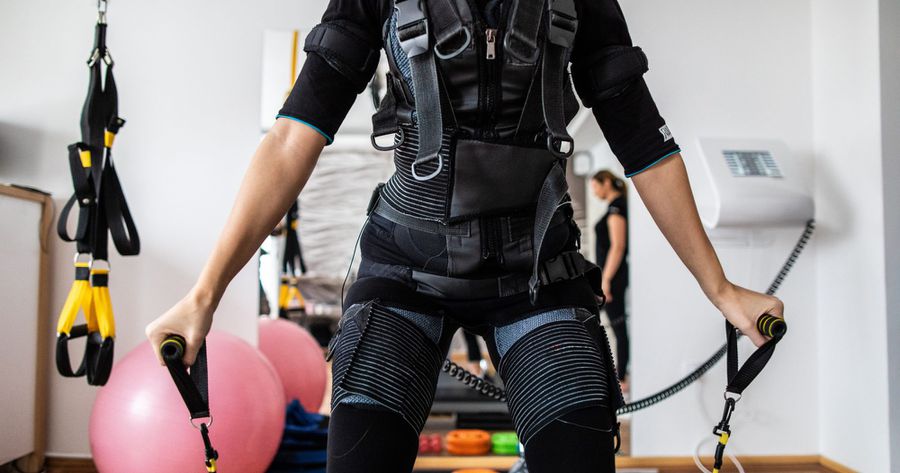
Imagine if you could reap the benefits of strength training without logging tons of hours at the gym.Instead, all it would take was a few quick 15-minute sessions hooked up to some wires and, violá, serious results. A pipe dream? Apparently not — at least according to the pros at Manduu, ReBalance, and Impulse Fitness, a few of the many new gyms incorporating electrical muscle stimulation (EMS) into workouts.
If you use e-stim in tandem with movement and weight, your muscles should get stronger than if you did the moves alone, according to some research. In a 2016 study, people who did a six-week squat program with EMS had greater strength improvements compared to those who did not use EMS.
So yes, the concept of EMS workouts seems to make sense, and, yes, some studies do support claims of boosted strength. However, research (of which there is very little) ranges in sample size, demographics, and findings. Case in point: A 2019 review of e-stim research actually found it was impossible to make any conclusions on EMS training’s effects.
“I think a person doing an EMS workout needs to have realistic expectations, especially if they’re using it to cut down minutes on the gym,” says Fulop. “EMS can temporarily strengthen, tone, or firm muscles to some extent, but it likely will not cause long-term improvements in health and fitness alone, according to the Food and Drug Administration (FDA),” she adds.
Another drawback: Electrical stimulation is “extremely difficult to dose properly,” says Nicola A. Maffiuletti, Ph.D., head of the Human Performance Lab at the Schulthess Clinic in Zurich, Switzerland. For this reason, it can present a risk of “under-dosage” (no or minimal training and therapeutic effects) or “overdosage” (muscle damage), he adds — and this can be especially relevant in a group class setting.
Is it safe to do an EMS workout?
"Not all EMS devices are 100 percent safe," says Fulop. "If you're getting EMS treatment by a physical therapist, then they're trained in applying this particular modality and use regulated, FDA-approved units," she adds.
Although using an unregulated product is not necessarily unsafe or dangerous, it can potentially cause burns, bruising, skin irritation, and pain, according to the FDA. All those wires and cables could also lead to electrocution, the organization also warns. So, it’s essential that you ask the trainer or gym about their devices and, if buying a device, do ample research before pressing “add to cart.”
And if you have a defibrillator or pacemaker, steering clear of EMS is recommended by the FDA. Pregnant people should also avoid e-stim (except for TENS, which is allowed), particularly on their low back or neck, says Fulop. "This could harm the baby and is not proven otherwise," she cautions.
It’s also important to note that studies have linked EMS to an increased risk of rhabdomyolysis (aka rhabdo), the damage or injury of muscles resulting in the release of muscle fiber contents into the blood, which can lead to serious complications such as kidney failure, according to the U.S. National Library of Medicine (NLM). But don’t freak out just yet: Although serious, rhabdo is rare. Plus, it’s not just a risk once you incorporate e-stim into your exercise routine. You can also get the condition from super intense strength training workouts, dehydration, and going too hard, too fast with a new exercise — one woman even got rhabdo from doing an intense pull-up workout.
Bottom line: EMS workout training sound exciting, and the pros are certainly possible, but keep in mind that supporting research hasn’t quite caught up yet. (In the meantime, though, you can always lift some heavy weights!)






































